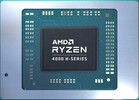AMD Ryzen 7 4800H vs Intel Core i7-11850H vs Intel Core i5-11400H
AMD Ryzen 7 4800H
► remove from comparison
The AMD Ryzen 7 4800H is a Renoir APU designed for larger, more powerful laptops with room for better termals. The Ryzen features eight Zen 2 cores running at 2.9 GHz (base clock speed) to 4.2 GHz (Boost). The CPU also has 8 MB of L3 cache and a Vega series integrated GPU. Thread-doubling SMT tech is enabled in this processor, allowing for up to 16 concurrent processing threads.
Architecture
Ryzen 7 4800H is manufactured on the modern 7 nm TSMC process and in part thanks to this fact AMD promises an up to 2x higher performance-per-watt figure compared to Ryzen 3000 series mobile APUs. This isn't the only noteworthy change however as Zen 2 architecture is leagues ahead of the outgoing Zen+ when it comes to single-core performance. Renoir family processors feature up to 8 CPU cores compared to 4 cores of the previous generation mobile AMD CPUs.
A 4800H will work with dual-channel DDR4-3200 or quad-channel LPDDR4-4266 RAM. The important difference between desktop Ryzen 4000 and mobile Ryzen 4000 processors is that the latter do not have PCI-Express 4.0 support, meaning those blazing-fast NVMe SSDs will be limited to a throughput of 3.9 GB/s.
The Ryzen 7 gets soldered straight to the motherboard (FP6 socket) and is thus not user-replaceable. Please go to our Renoir processor family hub for more information on these CPUs.
Performance
The average 4800H in our database is in the same league as the Core i7-11850H, the Core i7-1360P and also the Ryzen 7 PRO 6850U, as far as multi-thread benchmark scores are concerned. This highlights just how great of a job Renoir designers did, back in the day.
Thanks to its decent cooling solution and a long-term power limit of 45 W, the MSI Alpha 17 A4DEK is among the fastest laptops built around the 4800H that we know of. It can be more than 20% faster in CPU-bound workloads than the slowest system featuring the same chip in our database, as of August 2023.
Graphics
Ryzen 7 4800H features the Radeon RX Vega 7, a 7 CU integrated graphics adapter running at up to 1,600 MHz. The iGPU's underlying architecture is fairly old as of 2021, yet its 448 shaders will let you play many games of 2020 and 2021 as long as you stick to reasonable resolutions and presets. F1 2021 runs well at medium quality, 1080p resolution, to give you an example. A Vega 7 can be as fast as a GeForce GTX 1050 Max-Q, or as slow as an 80 EU Iris Xe; this depends on the benchmark as well as on cooling system performance and TDP settings of a laptop as mentioned above. As the iGPU has no VRAM of its own, it is paramount that fast system RAM is used.
The Vega definitely supports UHD 2160p monitors at 60 Hz. This iGPU is capable of hardware decoding AVC, HEVC and VP9-encoded videos. There is no AV1 support to be found here though. Such a video will have to be SW-decoded leading to much lower energy efficiency.
Power consumption
This Ryzen 7 series chip has a default TDP (also known as the long-term power limit) of 45 W. Laptop makers are allowed to change that to anything between 35 W and 54 W, with clock speeds and performance changing accordingly as a result. The Ryzen 7 4800HS is a 35 W edition of the Ryzen 7 4800H that trades away a bit of performance for lower power consumption. In both cases, an active cooling solution is a must.
Both the 4800H and the 4800HS are built with TSMC's 7 nm process for decent, as of late 2022, energy efficiency.
Intel Core i7-11850H
► remove from comparison
The Intel Core i7-11800H is a high end octa core SoC for gaming laptops and mobile workstations. It is based on the Tiger Lake H45 generation and will be announced in mid 2021. It integrates eight Willow Cove processor cores (16 threads thanks to HyperThreading). The base clock speed depends on the TDP setting and at 45 Watt is at 2.4 GHz. The single core boost speed can reach up to 4.6 GHz, all cores can reach up to 4.2 GHz. The CPU offers 24 MB level 3 cache and supports DDR4-3200 memory. Compared to the slower clocked i7-11800H, the 11850H offers professional management features like Intel vPro, SIPP or TXT.
Thanks to the new Tiger Lake architecture, the i9-11850H should be similar or faster than the old Intel Core i9-10875H (Comet Lake-H, 2.3 - 5.1 GHz, 16 MB L3) in single and multi threaded performance and similar to the Ryzen 9 5800H (Zen 3, 3.2 - 4.4 GHz, 16 MB L3). Therefore, the i7 is well suited for even very demanding tasks.
The SoC also includes the improved Xe graphics card called UHD graphics with all 32 EUs.
Furthermore, Tiger Lake SoCs add PCIe 4 support (20 lanes in the H45 series), AI hardware acceleration, and the partial integration of Thunderbolt 4/USB 4 and Wi-Fi 6E in the chip.
The chip is produced on the improved 10nm process (called 10nm SuperFin) at Intel, which should be comparable to the 7nm process at TSMC (e.g. Ryzen 4000 series). The default TDP is rated at 45 W at 2.4 GHz base speed, at 35 Watt the base clock speed decreases to 2 GHz (cTDP down).
All articles on Tiger Lake can be found on our Tiger Lake architecture hub.
Intel Core i5-11400H
► remove from comparison
The Intel Core i5-11400H is a high-end hexa-core SoC for gaming laptops and mobile workstations. It is based on the Tiger Lake H45 generation and was announced in mid 2021. It integrates six Willow Cove processor cores (12 threads thanks to HyperThreading). The base clock speed depends on the TDP setting and at 45 Watt is at 2.7 GHz. The single core boost speed can reach up to 4.5 GHz, all cores can reach up to 4.1 GHz. The CPU geatures 12 MB L3 cache and supports DDR4-3200 memory.
Furthermore, Tiger Lake SoCs add PCIe 4 support (20 lanes in the H45 series), AI hardware acceleration, and the partial integration of Thunderbolt 4/USB 4 and Wi-Fi 6E in the chip.
The SoC features an improved Gen 12 graphics adapter called UHD Graphics with 16 EUs.
All articles on Tiger Lake can be found on our Tiger Lake architecture hub.
Performance
The average 11400H in our database matches the Ryzen 5 5600U and the Core i7-10750H in multi-thread performance, rendering the Core i5 a decent mid-range option as of mid 2022. It isn't as fast as the mighty Ryzen 9 5900HS, yet it will let you run most games in High or even Ultra settings at 1080p if mated to a fast graphics card.
Thanks to its decent cooling solution and a long-term CPU power limit of 45 W, the Gigabyte G5 GD (2021) is among the fastest laptops built around the 11400H that we know of. It can be around 20% faster in CPU-bound workloads than the slowest system featuring the same chip in our database, as of August 2023.
Power consumption
This Core i5 series chip has a default TDP of 35 W to 45 W, the expectation being that laptop makers will go for a higher value in exchange for higher performance. Either way, an active cooling solution is a must for a CPU like this.
The i5-11400H is manufactured on Intel's 3rd generation 10 nm process marketed as SuperFin for below average, as of early 2023, energy efficiency.
| Model | AMD Ryzen 7 4800H | Intel Core i7-11850H | Intel Core i5-11400H | ||||||||||||||||||||||||||||||||||||||||||||||||||||||||||||||||||||||||||||||||||||||||||||
| Codename | Renoir-H (Zen 2) | Tiger Lake-H | Tiger Lake-H | ||||||||||||||||||||||||||||||||||||||||||||||||||||||||||||||||||||||||||||||||||||||||||||
| Series | AMD Renoir (Ryzen 4000 APU) | Intel Tiger Lake | Intel Tiger Lake | ||||||||||||||||||||||||||||||||||||||||||||||||||||||||||||||||||||||||||||||||||||||||||||
| Series: Tiger Lake Tiger Lake-H |
|
|
| ||||||||||||||||||||||||||||||||||||||||||||||||||||||||||||||||||||||||||||||||||||||||||||
| Clock | 2900 - 4200 MHz | 2500 - 4800 MHz | 2700 - 4500 MHz | ||||||||||||||||||||||||||||||||||||||||||||||||||||||||||||||||||||||||||||||||||||||||||||
| L1 Cache | 512 KB | 640 KB | 480 KB | ||||||||||||||||||||||||||||||||||||||||||||||||||||||||||||||||||||||||||||||||||||||||||||
| L2 Cache | 4 MB | 10 MB | 7.5 MB | ||||||||||||||||||||||||||||||||||||||||||||||||||||||||||||||||||||||||||||||||||||||||||||
| L3 Cache | 8 MB | 24 MB | 12 MB | ||||||||||||||||||||||||||||||||||||||||||||||||||||||||||||||||||||||||||||||||||||||||||||
| Cores / Threads | 8 / 16 | 8 / 16 | 6 / 12 | ||||||||||||||||||||||||||||||||||||||||||||||||||||||||||||||||||||||||||||||||||||||||||||
| TDP | 45 Watt | 45 Watt | 45 Watt | ||||||||||||||||||||||||||||||||||||||||||||||||||||||||||||||||||||||||||||||||||||||||||||
| Technology | 7 nm | 10 nm | 10 nm | ||||||||||||||||||||||||||||||||||||||||||||||||||||||||||||||||||||||||||||||||||||||||||||
| max. Temp. | 105 °C | 100 °C | 100 °C | ||||||||||||||||||||||||||||||||||||||||||||||||||||||||||||||||||||||||||||||||||||||||||||
| Socket | FP6 | BGA1787 | BGA1787 | ||||||||||||||||||||||||||||||||||||||||||||||||||||||||||||||||||||||||||||||||||||||||||||
| Features | DDR4-3200/LPDDR4-4266 RAM, PCIe 3, MMX, SSE, SSE2, SSE3, SSSE3, SSE4A, SSE4.1, SSE4.2, AVX, AVX2, BMI2, ABM, FMA, ADX, SMEP, SMAP, SMT, CPB, AES-NI, RDRAND, RDSEED, SHA, SME | DDR4-3200 RAM, PCIe 4, 8 GT/s bus, DL Boost, GNA, vPro, MMX, SSE, SSE2, SSE3, SSSE3, SSE4.1, SSE4.2, AVX, AVX2, AVX-512, BMI2, ABM, FMA, ADX, SMX, SMEP, SMAP, EIST, TM1, TM2, HT, Turbo, SST, AES-NI, RDRAND, RDSEED, SHA, TME | DDR4-3200 RAM, PCIe 4, 8 GT/s bus, DL Boost, GNA, MMX, SSE, SSE2, SSE3, SSSE3, SSE4.1, SSE4.2, AVX, AVX2, AVX-512, BMI2, ABM, FMA, ADX, VMX, SMEP, SMAP, EIST, TM1, TM2, HT, Turbo, SST, AES-NI, RDRAND, RDSEED, SHA | ||||||||||||||||||||||||||||||||||||||||||||||||||||||||||||||||||||||||||||||||||||||||||||
| iGPU | AMD Radeon RX Vega 7 ( - 1600 MHz) | Intel UHD Graphics Xe 32EUs (Tiger Lake-H) (350 - 1450 MHz) | Intel UHD Graphics Xe 16EUs (Tiger Lake-H) (350 - 1450 MHz) | ||||||||||||||||||||||||||||||||||||||||||||||||||||||||||||||||||||||||||||||||||||||||||||
| Architecture | x86 | x86 | x86 | ||||||||||||||||||||||||||||||||||||||||||||||||||||||||||||||||||||||||||||||||||||||||||||
| Announced | |||||||||||||||||||||||||||||||||||||||||||||||||||||||||||||||||||||||||||||||||||||||||||||||
| Manufacturer | www.amd.com | ark.intel.com | ark.intel.com |
Benchmarks
Average Benchmarks AMD Ryzen 7 4800H → 100% n=19
Average Benchmarks Intel Core i7-11850H → 109% n=19
Average Benchmarks Intel Core i5-11400H → 90% n=19
* Smaller numbers mean a higher performance
1 This benchmark is not used for the average calculation













